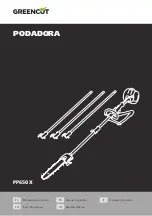
9
GB
10.5 Operating modes (fig. 1, 2)
The scroll saw is able to be operated manually or via the foot
pedal.
10.5.1 Manual controls
1. Ensure that the machine is switched on.
2. Set the operating mode selection switch (17) to the “M”
position to operate the saw manually.
3. Use the stroke rate controller (18) to set the appropriate
stroke rate for the material (see 10.4).
10.5.2 Foot pedal controls
1. Ensure that the machine is switched on.
2. Set the operating mode selection switch (17) to the “F”
position to operate the saw via the foot pedal (7).
3. The stroke rate may now be regulated via the foot pedal
position. If you depress the foot pedal (7) completely,
you will reach the maximum stroke rate.
CAUTION
When changing from foot pedal controls to manual controls,
the machine starts automatically. The stroke rate corresponds
with the stroke rate set on the stroke rate controller (18).
10.6 Making inside cuts
This scroll saw allows inside cuts in workpieces without damag-
ing the outside or the circumference of the workpiece.
1. Remove the saw blade (22) as described in 9.3.
2. Drill a hole into the workpiece.
3. Place the workpiece with the drilled hole over the open-
ing of the table inlay (26) on the saw table (6).
4. Install the saw blade (22) through the drilled hole in the
workpiece and set the blade tension.
5. After completing the inside cut, remove the saw blade
(22) from the blade holders (as described in 9.3).
6. Remove the workpiece from the table.
10.7 Miter cutting (fig. 14)
WARNING
Be especially careful when making miter cuts. The angle of the
saw table makes it easier for the workpiece to slip. There is a
danger of injury.
1. To carry out miter cuts adjust the distance of the blade
guard for worktable accordingly.
2. Swivel the saw table by loosening the locking lever (14)
and tilting the table (6) to the desired position.
3. Tighten the locking lever (14).
11. Electrical connection
The electrical motor installed is connected and
ready for operation. The connection complies with
the applicable VDE and DIN provisions.
The customer‘s mains connection as well as the
extension cable used must also comply with these
regulations.
Damaged electrical connection cable
The insulation on electrical connection cables is often dam-
aged.
This may have the following causes:
• Passage points, where connection cables are passed through
windows or doors.
• Kinks where the connection cable has been improperly fas-
tened or routed.
• Places where the connection cables have been cut due to being
driven over.
• Insulation damage due to being ripped out of the wall outlet.
• Cracks due to the insulation ageing.
Such damaged electrical connection cables must not be used
and are life-threatening due to the insulation damage.
Check the electrical connection cables for damage regularly.
Make sure that the connection cable does not hang on the
power network during the inspection.
Electrical connection cables must comply with the applicable
VDE and DIN provisions. Only use connection cables with the
marking H 05 VV-F.
The printing of the type designation on the connection cable
is mandatory.
AC motor
The mains voltage must be 220-240 V~
Extension cables up to 25 m long must have a cross-section of
1.5 mm
2
.
Connections and repairs of electrical equipment may only be
carried out by an electrician.
Please provide the following information in the event of any
enquiries:
• Type of current for the motor
• Machine data - type plate
12. Transport
• Transport the electric tool by lifting it on the recesses pro-
vided for this on the frame and the engine cover.
• Never use the protective devices for handling or transport.
• Make sure that the exposed part of the saw blade is covered
during transport, e. g. by the protective device.
Summary of Contents for PDS 120 B2
Page 3: ...4 1 3 5 2 3 4 5 6 7 8 9 10 12 11 2 17 13 14 15 16 18 19 21 20 A B C 1 D E G F E...
Page 5: ...15 14 6 14 9 13 33 32 35 34 8 16 36...
Page 55: ...50...
Page 57: ......
Page 58: ......
Page 59: ......















































